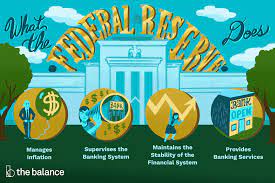Central Bank Collapse Is Coming
Is The Federal Reserve Next
Has The Federal Reserve Printed Itself Out Of Business?

In our history, we’ve had three central banks and three failures. Now it’s time for the Federal Reserve to face the music.
Concoda
Dec 23, 2020·7 min read

If you even dared to suggest that the Federal Reserve might lose all its power within the next decade, guess what? Everyone would laugh you out of the room. That’s because all recent generations, Boomers, Millennials, GenXers, GenZers, have grown up in a society where state intervention in the economy and in our finances has reached all-time highs. It’s hard to imagine a world without central banks coming to the rescue of our damsel-in-distress style economy.
[the_ad id=”3629″]
It’s so inherent in our way of thinking because the rise of big government has defined the latest American cycle, though, not in its size, but in its complexity. In 1966, the federal employee count peaked, yet the number of government agencies kept soaring to all-time highs. Subsequently, the makeup of the state has become so complex that any action any agency, bureau, or department performs either ends in failure or in success with an undesirable outcome. Complexity is the new currency we trade to achieve stability in the modern age.
In the Storm Before the Calm, George Friedman explains how this complexity made it impossible for the state to identify, let alone prevent, the subprime housing meltdown in 2007 and 2008. “There were federal agencies designed to facilitate mortgage lending, for supervising markets, for monitoring fraud, and for managing the economy, but they did not work with each other. Had they done so, the problem would have become apparent.” The U.S. government failed to spot the warning signs because its interventions made the mortgage market incomprehensible, and the experts hired to run the system lacked the unattainable wisdom required to consult with other agencies and spot an imminent collapse.
Since this complexity has spread to all branches of government, the unwind of institutional power is now inconceivable. After a while, no one really knows how the system works, destroying any chance of achieving prosperity. Further interventions designed to fix problems only create further defects, anomalies, and abnormalities. Increased regulation and taxes means we ship more of our manufacturing industry overseas, and we make up for the following shortages in jobs and productivity with more debt, which hinders our ability to produce further growth. A self-fulfilling economic death loop.
Though, to prevent an economic catastrophe, the elites have painted over the cracks. We have witnessed the rise of a fake economy, a crippled system run by experts who possess superior knowledge but lack the wisdom to recognize theirs and the system’s flaws. But as no one could imagine an alternative, this system has endured. Over time, bad actors have exploited the system, committing a range of crimes from pumping up asset prices in which they have become a majority holder to stealing, on average, 2% of our purchasing power each year.
These exploitations have been hidden from the public for decades, but with the rise of the information age, we have finally started to wake up to the economic shenanigans occurring behind the scenes. The three biggest anti-elite movements, the crypto nuts, the cypherpunks, and the gold bugs, have plucked up the courage to form a silent monetary revolution. Now, the financial elite’s primary weaponry, the Federal Reserve, remains under threat.
Gradually then suddenly, this creeping monetary revolution will cause the Federal Reserve’s downfall. Why? Because, without fail, all movements that aimed to overthrow a central bank have succeeded. During the Revolutionary War in 1782, defense contractor Robert Morris established America’s first central bank, the Bank of North America, and used it to siphon millions of the Treasury’s assets into his firm and the hands of his associates. After backlash, the bank was privatized in 1785 — and Morris escaped justice. In 1811, twenty-one years after America founded the First Bank of United States (America’s second central bank), Thomas Jefferson viewed it as a vehicle for “speculation, financial manipulation, and corruption”, expiring its charter soon after. Then, only five years later, it was James Madison’s turn to create the Second Bank of the United States (America’s third central bank). But, yet again, following claims of corruption and foul play, Andrew Jackson expired its charter.
With each of the former central banks collapsing after widespread allegations of fraud, the Federal Reserve’s time is limited. On every occasion, the central bank, their originators, and their sponsors felt the brunt of those that suffered within a centrally-planned economy, and this time, it’s no different. All we’re waiting for now is the catalyst that prompts the masses to pursue economic justice.
The Federal Reserve will collapse in one of two ways. The first scenario, where we, as a nation, rise up and oppose the vast, unchallenged corruption between Wall Street and the Federal Reserve, is unlikely anytime soon. Sadly, the elite’s linguistic and financial alchemy keeps their narrative in play. It’s a lot easier to persuade people to back a global central bank when you call it the IMF (International Monetary Fund). It’s a lot easier to profit from keeping the greatest wealth transfer machine in history on full power than it is to reset America’s failed economic system and earn wealth legitimately. Even though this hurts us, we overwhelmingly and unwillingly support this system. It’s why a monetary revolution has yet to occur.
The second, most likely route to collapse is the slow transfer of power from the bankers to another group of elites: politicians. The COVID-19 crisis allowed lawmakers to override the central bank’s procedures and force megabanks to pump money into the real economy via bank guarantees: emergency loans granted to the public to curb the economic impacts of Coronavirus. Rather than the central banks flooding the system with money and commercial banks deciding whether or not to make loans, politicians provided a backstop to cover losses when borrowers defaulted.
If the government can use this policy to not only deliver but outdo the central banks in creating economic growth, why bother having a central bank at all? That’s what some officials have begun to realize. Bank guarantees are here to stay. As a general rule, when a politician says that a policy is temporary, it will become permanent. The trillions they keep pumping into the economy will be nothing compared to what we’ll see in the future. When you intervene in an infinitely complex system, your attempts to fix a problem becomes self-fulfilling. That’s why our economy has countless defects, and why many can’t explain how many policies came to be and still exist today.
The alliance between the government and central bankers was born by tying the health of the economy to the value of speculative assets. This bond will come to an end. When the central banker’s toolbox fails, when the people lose faith in the “money printer goes brrr”, that’s when we’ll see the collapse of central banks and the rise of financial politicians. As the Fed becomes nothing more than an administrative agency, other global powers will follow suit, dismantling their central banks putting the power of money creation in the hands of the politicians.
Of course, it’s hard to imagine how they will take the power away from central bankers. But there’s a public perception, the narrative that banks and bankers are to blame for this prolonged global economic rout. The politicians will use citizen’s anger from multiple financial crises as a political weapon. Pair this with other factors such as all of the megabanks having shares in the Federal Reserve, and you have a solid case for the people supporting a transfer of power from the bankers to the state.
Once politicians gain monetary power, however, desperate times call for desperate measures. They will embrace MMT (modern monetary theory): the freshest economic theory which claims to solve our problems. In reality, it’s more money printing but with a new look. They will realize before it’s too late that the very thing that gave them power will undo what has kept the flawed monetary system stable: deflation.
After the 2008 financial crisis, most economists predicted that QE — quantitative easing — would create hyperinflation, but instead, it appeared in every speculative asset class from real estate to corporate bonds. This time, MMT will create rampant inflation but it will also emerge in the real economy. First, though, MMT will produce an unprecedented economic boom as the state suppresses loan and mortgage rates while wages increase through inflation. Initially, this is good for the person on the street, however, they won’t anticipate the following hyperinflation. No power has ever managed to suppress interest rates forever while pumping trillions into the real economy.
The hyperinflationary collapse will create a small window of opportunity for the emerging monetary powers to gain dominance. Like when Jefferson put us on the Gold Standard, like when the First and Second Bank of United States charters expired, the collapse of the Federal Reserve will urge all sides to fight for control of the narrative. Nongovernmental and governmental forces will battle it out to implement their vision of a modern monetary hegemony; a struggle for power between citizen-led movements, such as Bitcoin and Ethereum, and the state. It’s up to the new paradigms that keep power in the hands of the people instead of the same bureaucratic regime which always prevails, where elites create powerful narratives to blind citizens from their real intent, where the new wealth transfer mechanisms produce the same rampant inequalities as their predecessors.
Who will be the victor? Who will end up with all the power? The people or the elites? When the politicians take monetary authority away from the central bankers, there’s no guarantee they will give it back to the people. This depends on our future perceptions. We have embraced, using the British expression, a nanny state. We have been programmed to lust after free money and handouts, to abandon personal responsibility, to outsource our intelligence to others, letting someone “smarter” handle life’s complexities.
Until this reliance on big government unwinds, we’ll look to those in power to solve our financial woes even if it hurts us in the long run. When the Federal Reserve collapses, the same cycle will start over. To the dismay of those who remain vigilant, we’ll see history repeat itself with the power and wealth ending up in a specific set of hands, and the slow, inevitable installation of America’s next, even more detestable, even more crooked, central bank.
This article is for educational purposes only, not financial advice.
Concoda
Navigating the absurdity of late-stage capitalism. Subscribe via https://concoda.medium.com/membership or https://concoda.substack.com
Central Bank Collapse Is Coming

VISIT OUR OTHER SITES:
Check Out Our Crypto Privacy Site: CryptoGrizz.com
Check Out Our Crypto Trading Site: CryptoGrizzTrader.com
Check Out Our Low Cap Altcoin Site: CryptoGrizzAltcoins.com
Check Out Our Prepper Site: PrepperGrizz.com
Check Out Our Global Crypto Survival Site: GlobalCryptoSurvival.com